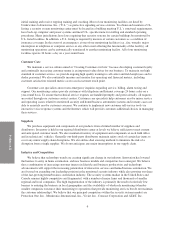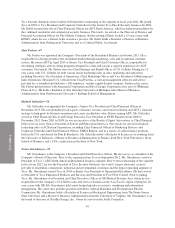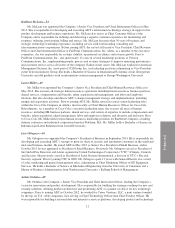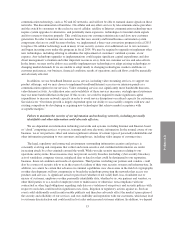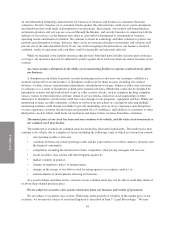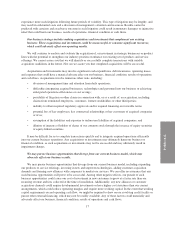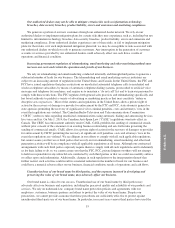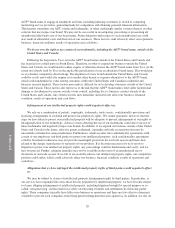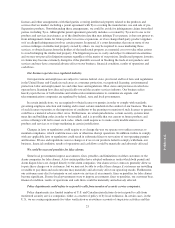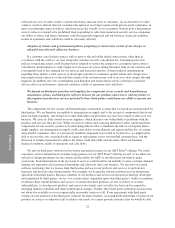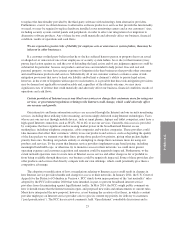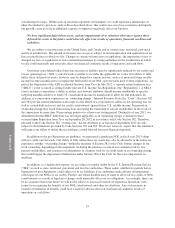ADT 2014 Annual Report Download - page 81
Download and view the complete annual report
Please find page 81 of the 2014 ADT annual report below. You can navigate through the pages in the report by either clicking on the pages listed below, or by using the keyword search tool below to find specific information within the annual report.
FORM 10-K
communication technology, such as 3G and 4G networks, and will not be able to transmit alarm signals on these
networks. The discontinuation of land-line, 2G cellular and any other services by telecommunications providers,
and the switch by customers to the exclusive use of cellular, satellite or Internet communication technology may
require system upgrades to alternative, and potentially more expensive, technologies to transmit alarm signals
and for systems to function properly. This could increase our customer attrition rates and slow new customer
generation. In order to maintain our customer base that uses security and home/business automation system
components that are or could become obsolete, we implemented a three-year conversion program in fiscal 2013
to replace 2G cellular technology used in many of our security systems at no additional cost to our customers,
and began incurring costs under this program in fiscal 2014. We may be required to upgrade or implement other
new technologies, including offering to subsidize the replacement of customers’ outdated systems, at our
expense. Any technology upgrades or implementations could require significant capital expenditures and also
divert management’s attention and other important resources away from our customer service and sales efforts.
In the future, we may not be able to successfully implement new technologies or adapt existing technologies to
changing market demands. If we are unable to adapt timely to changing technologies, market conditions or
customer preferences, our business, financial condition, results of operations and cash flows could be materially
and adversely affected.
In addition, we use broadband Internet access service, including video streaming services, to support our
product offerings, and we may choose to implement broadband Internet access in our intrusion panels as a
communications option for our services. Video streaming services use significantly more bandwidth than non-
video Internet activity. As utilization rates and availability of these services increases, our high-speed customers
may use more bandwidth than in the past. If this occurs, we could be required to make significant capital
expenditures to increase network capacity in order to avoid service disruptions or reduced capacity for customers.
See risk factor “Our future growth is largely dependent upon our ability to successfully compete with new and
existing competitors by developing or acquiring new technologies that achieve market acceptance with
acceptable margins.”
Failure to maintain the security of our information and technology networks, including personally
identifiable and other information could adversely affect us.
We are dependent on information technology networks and systems, including Internet and Internet-based
or “cloud” computing services, to process, transmit and store electronic information. In the normal course of our
business, we or our partners collect and retain significant volumes of certain types of personally identifiable and
other information pertaining to our customers and employees, including video images of customer sites.
The legal, regulatory and contractual environment surrounding information security and privacy is
constantly evolving and companies that collect and retain sensitive and confidential information are under
increasing attack by cyber-criminals around the world. While we take security measures relating to our
operations and systems, those measures may not prevent security breaches (including cyber security breaches),
acts of vandalism, computer viruses, misplaced data or data loss that could be detrimental to our reputation,
business, financial condition and results of operations. Third parties, including our partners and vendors, could
also be a source of security risk to us in the event of a failure of their own security systems and infrastructure. In
addition, we cannot be certain that advances in criminal capabilities, new discoveries in the field of cryptography
or other developments will not compromise or breach the technology protecting the networks that access our
products and services. A significant actual or perceived (whether or not valid) theft, loss, fraudulent use or
misuse of customer, employee or other personally identifiable data, whether by us, our partners and vendors, or
other third parties or as a result of employee error or malfeasance or otherwise, non-compliance with our
contractual or other legal obligations regarding such data or a violation of our privacy and security policies with
respect to such data could result in significant costs, fines, litigation or regulatory actions against us. Such an
event could additionally result in unfavorable publicity and therefore adversely affect the market’s perception of
the security and reliability of our services, and our credibility and reputation with our customers, which may lead
to customer dissatisfaction and could result in lost sales and increased customer attrition. In addition, we depend
15



